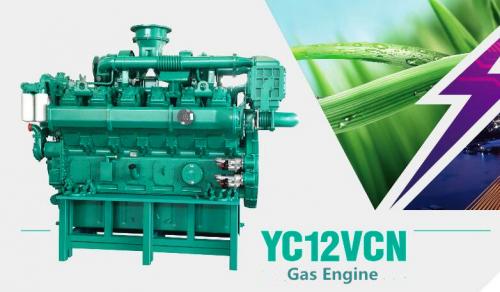Liquefied Petroleum Gas, Field Gas and Biogas

2.4.7.1
Liquefied
Petroleum Gas
Liquefied petroleum gas
(LPG) is composed primarily of propane and/or butane. While propane and butane
ratings are higher than gasoline, most stationary spark ignition engines are
designed with higher compression ratios that optimize operation with natural
gas and its associated high methane number.
Use of fuels with lower
methane numbers like LPG in natural gas engines requires retarding of ignition timing
and other appropriate adjustments to avoid detonation (knocking). LPG often
serves as a back-up fuel where there is a possibility of interruption in the
natural gas supply. Off-spec LPG may require cooling to condense out larger
volumes of butane or heavier hydrocarbons that would aggravate engine knock.
High butane content LPG is recommended only for low compression, naturally
aspirated engines.
2.4.7.2
Field Gas
Field gas often contains
more than 5 percent by volume of heavy ends (butane and heavier), as well as water,
salts and H2S and usually requires some scrubbing before use in natural gas
engines. Cooling may be required to reduce the concentrations of butane and
heavier components. Field gas usually contains some propane and normally is used in low
compression engines (both naturally aspirated and turbocharged). Retarded
ignition timing eliminates detonation.
2.4.7.3
Biogas
Biogases (landfill gas
and digester gas) are predominantly mixtures of methane and CO2 with HHV in the
range of 300 to 700 Btu/scf. Landfill gas also contains a variety of
contaminants as discussed earlier.
Biogases are produced
essentially at or somewhat below atmospheric pressure so must be compressed for
delivery to the engine. After compression, cooling and scrubbing or filtration
are required to remove compressor oil, condensate, and any particulates that
may have been entrained in the original gas.
Scrubbing with a caustic
solution may be required if acid gases are present. Because of the additional requirements
for raw gas treatment, biogas powered engine facilities are more costly to
build and operate than natural gas-based systems.
A key contaminant in
biogas is a class of compounds called siloxanes, a subgroup of silicones
containing Si-O bonds with organic radicals. These compounds are widely used
for a variety of industrial processes and are also commonly added to consumer
products, including detergents, shampoos, cosmetics, paper coatings, and textiles.
Siloxanes in wastewater do not break down in wastewater treatment facilities or
in landfills. As sludge undergoes anaerobic digestion, it may be subjected to
temperatures of up to 150 o F. At these temperatures, siloxanes volatilize and
enter the gas stream. Subjected to the heat of combustion in a reciprocating
engine (turbine or microturbine), siloxanes leave behind hard deposits of silica
on pistons and valve assemblies causing abrasion and impact damage that reduce
the life and efficiency of the engine. Siloxanes need to be removed using
refrigeration or sorbents such as activated carbon, alumina, synthetic resins,
or liquid sorbents.25
For engines operating on
biogas, additional capital investment is required for this fuel clean-up, compression,
and sometimes derating of the engine capacity due to the lower thermal energy
content of the fuel. For a 1,000 kW reciprocating engine, the added equipment
and installation cost is about $600/kW.26 Smaller systems can require nearly
the same amount of equipment, so unit costs go up rapidly on smaller
installations.
Improved engine design
and hardened valve seats reduce siloxane damage on engines, thereby reducing the
need for complete removal.
2.4.7.4
Industrial Waste Gases
Industrial waste gases
that are common used as reciprocating engine fuels include refinery gases and process
off-gases. Refinery gases typically contain components such as H2, CO, light
hydrocarbons, H2S, and ammonia, as well as CO2 and N2. Process off-gases
include a wide variety of compositions. Generally, waste gases are medium- to
low-Btu content. Medium-Btu gases generally do not require significant engine
derating; low-Btu gases usually require derating.
Depending on their
origin and contaminants, industrial gases sometimes require pretreatment comparable
to that applied to raw landfill gas. Particulates (e.g., catalyst dust), oils,
condensable gases, water, C4+ hydrocarbons and acid gases may all need to be
removed. Process offgases are usually available at pressures of several
atmospheres or higher, which are generally satisfactory for delivery to an
on-site or nearby reciprocating engine facility.
2.4.8
System Availability
The percentage of time
that a system is either up and running or available for use is referred to as
its availability. Systems are unavailable during periods of scheduled
maintenance or forced outages.
Reciprocating engines
are maintenance intensive but, they can provide high levels of availability,
even in high load factor applications. While natural gas engine availabilities
vary with engine type, speed and fuel quality, Table 2-8 illustrates typical
availability numbers based on a survey of natural gas engine gensets in CHP
applications.
Some engine
manufacturers offer engine exchange programs or other maintenance options that increase
the ability to promptly deliver and install replacement units on short notice,
typically increasing facility availabilities to greater than 95 percent. The
use of multiple units or back-up units at a site can further increase the
availability of the overall facility over 99 percent.
Post Your Ad Here
Comments